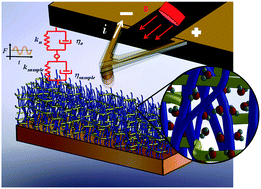Nano-rheology of hydrogels using direct drive force modulation atomic force microscopy†
Abstract
We present a magnetic force-based direct drive modulation method to measure local nano-rheological properties of soft materials across a broad frequency range (10 Hz to 2 kHz) using colloid-attached atomic force microscope (AFM) probes in liquid. The direct drive method enables artefact-free measurements over several decades of excitation frequency, and avoids the need to evaluate medium-induced hydrodynamic drag effects. The method was applied to measure the local mechanical properties of polyacrylamide hydrogels. The frequency-dependent storage stiffness, loss stiffness, and loss tangent (tan δ) were quantified for hydrogels having high and low crosslinking densities by measuring the amplitude and the phase response of the cantilever while the colloid was in contact with the hydrogel. The frequency bandwidth was further expanded to lower effective frequencies (0.1 Hz to 10 Hz) by obtaining force–displacement (FD) curves. Slow FD measurements showed a recoverable but highly hysteretic response, with the contact mechanical behaviour dependent on the loading direction: approach curves showed Hertzian behaviour while retraction curves fit the JKR contact mechanics model well into the adhesive regime, after which multiple detachment instabilities occurred. Using small amplitude dynamic modulation to explore faster rates, the load dependence of the storage stiffness transitioned from Hertzian to a dynamic punch-type (constant contact area) model, indicating significant influence of material dissipation coupled with adhesion. Using the appropriate contact model across the full frequency range measured, the storage moduli were found to remain nearly constant until an increase began near ∼100 Hz. The softer gels' storage modulus increased from 7.9 ± 0.4 to 14.5 ± 2.1 kPa (∼85%), and the stiffer gels' storage modulus increased from 16.3 ± 1.1 to 31.7 ± 5.0 kPa (∼95%). This increase at high frequencies may be attributed to a contribution from solvent confinement in the hydrogel (poroelasticity). The storage moduli measured by both macro-rheometry and AFM FD curves were comparable to those measured using the modulation method at their overlapping frequencies (10–25 Hz). In all cases, care was taken to ensure the contact mechanics models were applied within the important limit of small relative deformations. This study thus highlights possible transitions in the probe–material contact mechanical behaviour for soft matter, especially when the applied strain rates and the material relaxation rates become comparable. In particular, at low frequencies, the modulus follows Hertzian contact mechanics, while at high frequencies adhesive contact is well represented by punch-like behaviour. More generally, use of the Hertz model on hydrogels at high loading rates, at high strains, or during the retraction portion of FD curves, leads to significant errors in the calculated moduli.



 Please wait while we load your content...
Please wait while we load your content...